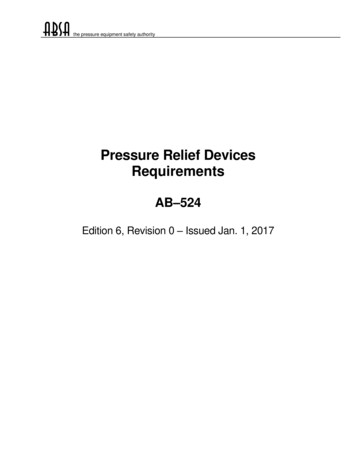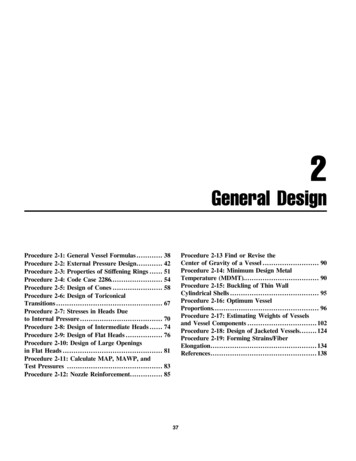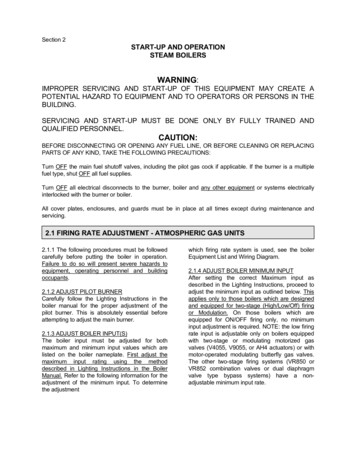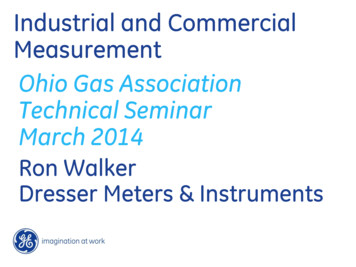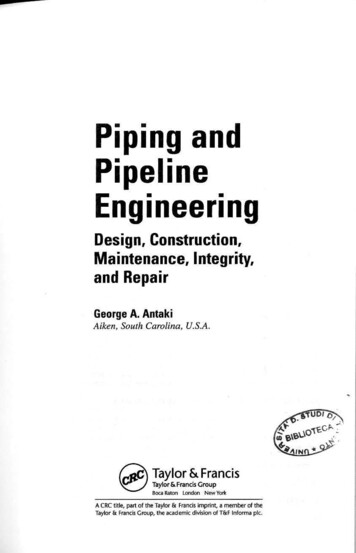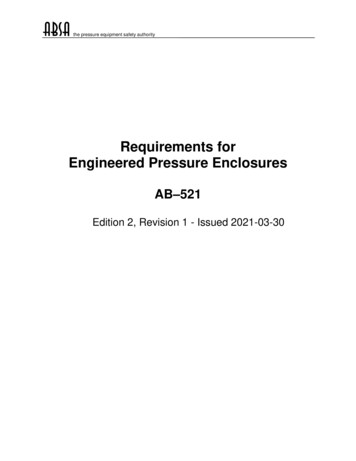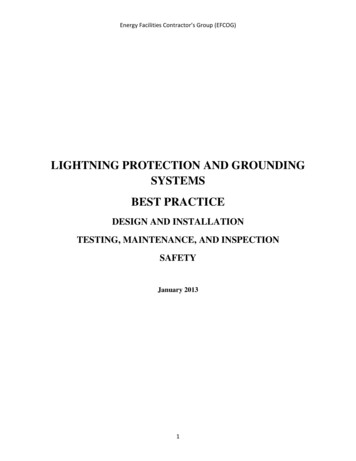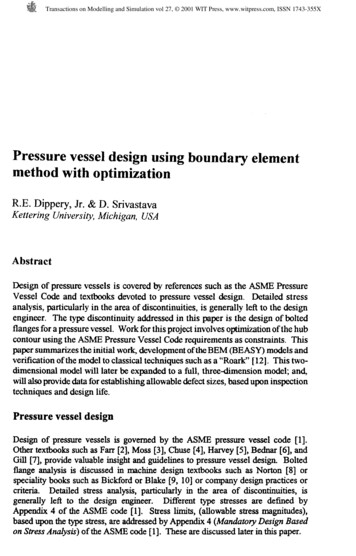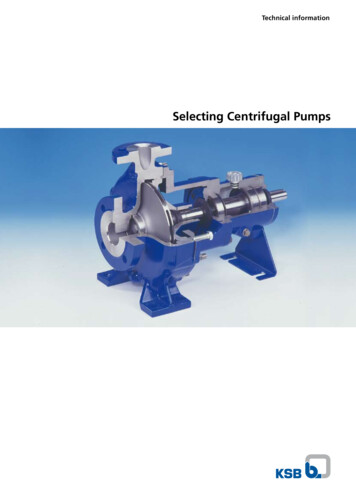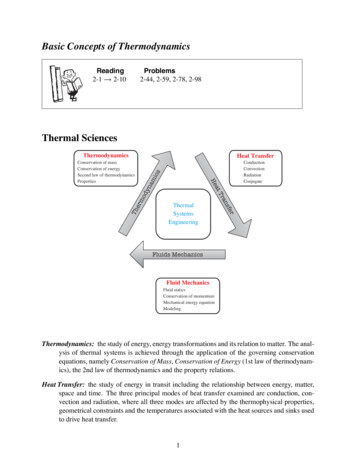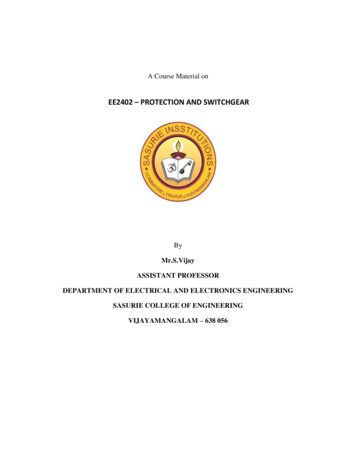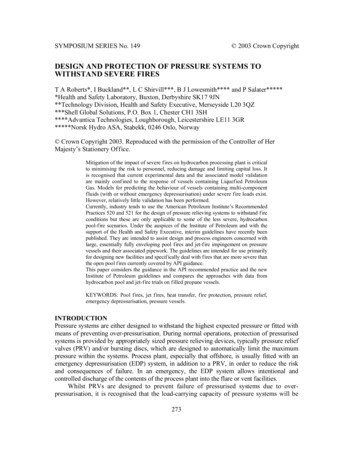
Transcription
SYMPOSIUM SERIES No. 149 2003 Crown CopyrightDESIGN AND PROTECTION OF PRESSURE SYSTEMS TOWITHSTAND SEVERE FIREST A Roberts*, I Buckland**, L C Shirvill***, B J Lowesmith**** and P Salater******Health and Safety Laboratory, Buxton, Derbyshire SK17 9JN**Technology Division, Health and Safety Executive, Merseyside L20 3QZ***Shell Global Solutions, P.O. Box 1, Chester CH1 3SH****Advantica Technologies, Loughborough, Leicestershire LE11 3GR*****Norsk Hydro ASA, Stabekk, 0246 Oslo, Norway Crown Copyright 2003. Reproduced with the permission of the Controller of HerMajesty’s Stationery Office.Mitigation of the impact of severe f ires on hydrocarbon processing plant is criticalto minimising the risk to personnel, reducing damage and limiting capital loss. Itis recognised that current experimental data and the associated model validationare mainly conf ined to the response of vessels containing Liquef ied PetroleumGas. Models for predicting the behaviour of vessels containing multi-componentf luids (with or without emergency depressurisation) under severe f ire loads exist.However, relatively little validation has been performed.Currently, industry tends to use the American Petroleum Institute’s RecommendedPractices 520 and 521 for the design of pressure relieving systems to withstand f ireconditions but these are only applicable to some of the less severe, hydrocarbonpool-f ire scenarios. Under the auspices of the Institute of Petroleum and with thesupport of the Health and Safety Executive, interim guidelines have recently beenpublished. They are intended to assist design and process engineers concerned withlarge, essentially fully enveloping pool f ires and jet-f ire impingement on pressurevessels and their associated pipework. The guidelines are intended for use primarilyfor designing new facilities and specif ically deal with f ires that are more severe thanthe open pool f ires currently covered by API guidance.This paper considers the guidance in the API recommended practice and the newInstitute of Petroleum guidelines and compares the approaches with data fromhydrocarbon pool and jet-f ire trials on f illed propane vessels.KEYWORDS: Pool fires, jet f ires, heat transfer, f ire protection, pressure relief,emergency depressurisation, pressure vessels.INTRODUCTIONPressure systems are either designed to withstand the highest expected pressure or fitted withmeans of preventing over-pressurisation. During normal operations, protection of pressurisedsystems is provided by appropriately sized pressure relieving devices, typically pressure reliefvalves (PRV) and/or bursting discs, which are designed to automatically limit the maximumpressure within the systems. Process plant, especially that offshore, is usually fitted with anemergency depressurisation (EDP) system, in addition to a PRV, in order to reduce the riskand consequences of failure. In an emergency, the EDP system allows intentional andcontrolled discharge of the contents of the process plant into the flare or vent facilities.Whilst PRVs are designed to prevent failure of pressurised systems due to overpressurisation, it is recognised that the load-carrying capacity of pressure systems will be273
SYMPOSIUM SERIES No. 149 2003 Crown Copyrightsignificantly compromised by exposure to fire. This occurs as a consequence of reduction ofthe strength of the vessels and pipe-work with increasing temperature. In general, there willbe critical temperatures where, for example, vessels will fail, valves will cease to functionadequately and/or flange connections will loosen. Pressure systems can also fail due to theincreasing pressure exerted by their contents as these to rise in temperature and if the reliefsystem is inadequate. Hence, the ability of pressure relieving and depressurisation systemsto safeguard pressurised systems in a fire is critically dependent upon the assumptions madeabout the type and size of the threatening fire.Currently, industry tends to use American Petroleum Institute’s RecommendedPractices 5201 and 5212 for the specification of pressure relieving systems to enablepressurised plant to withstand fire conditions. However, these are restricted to some of theless severe hydrocarbon pool-fire scenarios. Under the auspices of the Institute ofPetroleum, and with the support of the Health and Safety Executive, interim guidelines3have recently been published. They are intended to assist design and process engineersconcerned with large, essentially fully enveloping pool fires and jet-fire impingement onpressure vessels and their associated pipework. The guidelines are intended for useprimarily for designing new facilities and specifically deal with fires that are more severethan the limited sizes of open pool fires currently covered by API guidance.This paper considers the approaches in the API Recommended Practice 5212 and thenew Institute of Petroleum guidelines3 and compares the approaches using data fromkerosene pool-fire trials and flashing-liquid propane jet-fire trials on filled, horizontal,cylindrical propane vessels. A brief consideration of EDP systems is also given.MANAGEMENT OF FIRE HAZARDSSafe operation does not rely solely on the protection afforded by relief and depressurisingsystems. Indeed, pressure relief and depressurising systems are safeguard measures that onlycome into play when other measures aimed at preventing fires have failed. Good design (forexample, careful use of flanged connections), elimination of potential ignition sources (e.g.hazardous area classification and permit-to-work procedures; such as for hot work), and earlyfire detection and response (in the unlikely event that ignition does occur) all play a role.As shown later, pressure relief and depressurisation do not guarantee that vessels will notfail in a fire, particularly a severe fire. In principle, depressurisation and fire protection canprevent vessels from failing, but in practice the adequacy of these measures must be judged inthe context of the likelihood and consequences of vessel failure. For example, a higher level ofsafeguards will be required on a manned offshore facility or onshore installation with offsitepopulations in close proximity, than on a small vessel in a remote location.It is now common practice to carry out a fire risk analysis where measures taken toreduce the risk of a fire occurring, and the effectiveness of mitigation measures should afire occur, are all included. Depending on the nature and size of the facility, the fire riskanalysis may range from a simple assessment through to a fully quantified risk assessment(QRA). For offshore facilities, this would be part of the Fire and Explosion Strategy (FES)outlined in ISO 137024. For onshore installations, this would be incorporated in the processsafety management system for the plant and, where applicable, form part of the safety reportor demonstration of safe operation to the competent or regulatory authority.274
SYMPOSIUM SERIES No. 149 2003 Crown CopyrightCURRENT INDUSTRY PRACTICEA survey (under the auspices of the Institute of Petroleum (IP)), of a world-wide range(circa 160 organisations) of operators/owners, consultants and design contractors, indicatedthat there was no consistent approach or consensus on what criteria to use to design againstthe risk of severe fires. The main conclusions from the responses and information receivedwere:(a) There is little consistency in the design methodology used, even within a singlecompany;(b) Some said they had limited in-house expertise and engaged a specialist designcontractor; and(c) Some applied API RP 521 and assumed that by designing to that code, there was noadditional risk.There appeared to be no industry-preferred methodology and this has been taken as beingthe justification for preparing interim IP guidelines.Whilst the recommendations and equations in API RP 521 are generally applicable to arefinery or chemical plant, they were never intended to cover all fire scenarios, especiallythose that may foreseeably occur on offshore installations. The scope and application doesnot apply to very large enveloping pool fires or impinging jet fires. Hence, should processplant fitted with protective systems designed to API RP 521 or a similar standard beexposed to severe fires, such systems may be insufficient to prevent failure of the vesselbefore the inventory has been safely removed. Should the vessel contain a hazardousinventory (usually flammable hydrocarbons), the consequences of failure will becompounded with potentially catastrophic results and escalation of the event.AMERICAN PETROLEUM INSTITUTE RECOMMENDED PRACTICE 521As indicated above, industry has traditionally used the American Petroleum Institute’sRecommended Practice 5212 when designing pressure vessels to withstand the effects offire. When a pressure vessel containing liquid and vapour hydrocarbons is heated by fire,there are two main considerations:(1) Heat will be transferred to the contents thereby increasing the pressure.(2) The vessel wall not in contact with liquid may be heated to a point where the vessel fails.HEAT TRANSFER TO THE CONTENTSThe basic formulae given in API 521 for the heat absorbed by the contents of a vesselengulfed in fire is:Q 43.2 F A0.82 (with adequate drainage)(1)Q 71.0 F A0.82 (without adequate drainage)(2)where Q is the heat absorbed (kW), A is the effective wetted surface area of vessel (m2) andF is an environment factor.The effective wetted area of the vessel is defined as the surface area of the vessel incontact with liquid up to a height of 7.62 m (25 ft) above ground level or other surface that275
SYMPOSIUM SERIES No. 149 2003 Crown Copyrightcould sustain a fire. Effective elevation is based on observations that wind and shapeeffects limit the contact of the fire with the vessel as the elevation increases. Somecompanies use larger values for the effective elevation. The philosophy of wetted area isthat heat transferred to the liquid will eventually cause it to boil and produce more vapour,whereas heat transferred to the vapour phase will just cause vapour expansion. Theenvironmental factor (F) is an attempt to correct the heat flow for the effect of insulation,water drenching and earth covering. The values used for F and limits of application give riseto most conflicts between codes (see Parry5).HEAT TRANSFER TO THE UNWETTED SURFACEHeat input from an open fire to the bare outside surface of an unwetted wall may, in time,be sufficient to heat the vessel wall to a temperature high enough to rupture the vessel. APIRP 521 gives two illustrative figures. The first figure gives the average rate of heating ofsteel plates exposed to an open gasoline fire on one side. Observed data (mean temperatureversus time) for plate 3.2 mm (1/8 inch) thick are given together with computations forplates 3.2 mm, 12.7 mm and 25.4 mm thick. The second figure illustrates the effect (rupturestress versus time at indicated temperature) of overheating steel (AST A 515, Grade 79).INSTITUTE OF PETROLEUM INTERIM GUIDANCEScandpower Risk Management AS6 have prepared a guideline for protection of pressurisedsystems exposed to fire for Statoil and Norsk Hydro. It is based on Norsk Hydro’s internalguidance and is primarily concerned with the design of systems fitted with emergencydepressuring systems (EDP), although much of the information given is also relevant toother systems. The guidance produced by the Institute of Petroleum (IP) draws heavily onthis guideline in relation to EDP. However, the IP guidance3 has a wider scope in that it isintended to also cover vessels, e.g. storage vessels, which are not normally fitted with EDPsystems. The key components of the IP guidance are: An outline of the design process;fire types and thermal loading;Equipment response and failure prediction;Protective measures; andAreas of uncertainty, which might warrant further study.The IP guidelines are intended to supplement the existing codes and should be used inconjunction with them. The main differences between the IP and API guidance are inrelation to severe fires. These are considered as follows.MEASURED HEAT FLUXESOver the past 15 years, there has been a number of joint industry projects designed togenerate data for the validation of models for predicting the response to open and confinedsevere hydrocarbon pool and jet fires. It is not the intention to review this data here butsome of the key references are given as background information to the proposed valuesgiven later:276
SYMPOSIUM SERIES No. 149 2003 Crown CopyrightMost of the experimental data prior to 1991 are summarised in reports produced as partof Phase 1 of the Blast and Fire Engineering Project for Topside Structures (Cowleyand Johnson7 and Cowley8).Data on free and impinging horizontal jet fires were obtained as part of two EuropeanCommunity (EC) projects viz. AA and JIVE. As part of project AA (Two-phasereleases for toxic and flammable substances: Thermal initiation, source terms and fireeffects), a programme of large-scale steady state ignited jet releases of natural gas andliquefied petroleum gas (LPG) was performed during the period 1988 – 1989. A totalof 125 individual experimental data sets were prepared, including 68 experiments inwhich the fires impacted onto a cylindrical vessel or a pipe. Cowley and Pritchard9published some of the work in regard to the thermal impact on structures.The JIVE project10 was concerned with the Hazard consequences of jet fireinteractions with vessels containing pressurised liquids. Part of the project wasconcerned with taking 2 tonne propane tanks to failure11 via a nominal 2 kg s–1 flashingliquid propane jet fire. Another part of the JIVE programme of work, performed byDavenport12, involved measurement of the impact of the flames from the naturalgas/butane mixtures on targets.In 1995, Gosse and Pritchard13 studied the heat transfer from vertical natural gasjet fires impacting on
The basic formulae given in API 521 for the heat absorbed by the contents of a vessel engulfed in fire is: Q 43.2 F A0.82 (with adequate drainage) (1) Q 71.0 F A0.82 (without adequate drainage) (2) where Q is the heat absorbed (kW), A is the effective wetted surface area of vessel (m2) and F is an environment factor. The effective wetted area of the vessel is defined as the surface area of .
